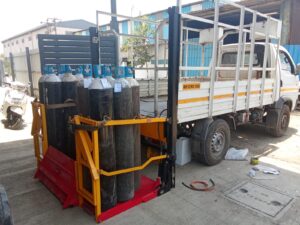If you’re looking for a practical, efficient solution for handling heavy cargo, a hydraulic tail gate lifts offers a modern and reliable answer. Widely used in logistics, manufacturing, and transportation sectors, these systems simplify loading and unloading, improve safety, and boost operational efficiency.
This guide walks you through everything you need to know—from how they work to how to choose, maintain, and get the best return on investment from a hydraulic tail gate lift.

What is a Hydraulic Tail Gate Lift and How Does It Work?
A hydraulic tail gate lift is a mechanical platform mounted on the rear of a truck or van, designed to raise and lower heavy loads using hydraulic power. At its core, the system includes a hydraulic pump, cylinders, and control mechanisms. When activated, fluid pressure moves the platform up or down, enabling smooth, controlled lifting with minimal manual effort.
Typically, these lifts are constructed with sturdy materials, non-slip platforms, and crucial safety features including emergency stop controls and overload protection. Some models can extend horizontally, making them especially useful in tight urban areas or confined loading zones.
Types of Hydraulic Tail Gate Lifts
Hydraulic tail gate lifts come in various configurations, designed to match different vehicle types and meet diverse operational requirements.
- Column Lifts: Vertical lifting using guided columns, ideal for high-capacity applications.
- Cantilever Lifts: Designed with extending arms for better accessibility, particularly useful in urban or space-restricted settings.
- Tuck-Away Lifters: These lifts retract under the car when not in use, allowing for unrestricted cargo access and a streamlined appearance.
Investing in a hydraulic tail gate lift offers several advantages:
Reduced Manual Labor: Minimize physical strain and risk of injury during loading/unloading.
Increased Productivity: Speed up material handling tasks, improving turnaround times.
Whether for a delivery fleet or a construction supply truck, these lifts bring consistent, measurable value.
Choosing the Right Hydraulic Tail Gate Lift
Weight Capacity: Choose a lift that matches or exceeds your cargo weight requirements.
Platform Size: Ensure the platform is wide and deep enough for your typical load.
Vehicle Interoperability: Make sure your car can handle the weight and size of the lift.
Usage Environment: For confined urban routes, consider compact or tuck-away models.
A proper assessment helps maximize both safety and operational efficiency.
Maintenance and Safety Guidelines
To guarantee sustained operation, routine maintenance is necessary:
- Check hydraulic fluid levels and seals regularly.
- Check wiring, control panels, and emergency stop systems for wear and problems on a regular basis.
- Clean and lubricate moving parts as needed.
- Train operators on safe usage practices and encourage pre-use inspections to catch potential issues early.
Troubleshooting Common Issues
Even well-maintained elevators can occasionally experience issues like:
Hydraulic Leaks: Usually due to worn seals or hoses.
Unresponsive Controls: Often related to electrical faults or low power supply.
Uneven Lifting: May result from air in the system or hydraulic imbalance.
Quick diagnostics and repairs save downtime and help prevent further damage.
Cost and Return on Investment
While the upfront cost of a hydraulic tail gate lifts can vary, its long-term benefits often outweigh the initial expense. Reduced labor costs, fewer workplace injuries, and faster deliveries contribute to a solid return on investment. Additionally, maintenance costs are typically low when lifts are used and serviced correctly.
Final Thoughts
A hydraulic tail gate lifts is more than just a tool—it’s a strategic asset for businesses that handle heavy cargo. From improved safety and efficiency to reduced labor dependency, these systems offer a smarter way to move goods.
By choosing the right lift, maintaining it properly, and training operators, businesses can significantly improve logistics workflows while protecting both workers and cargo.
Whether you operate in logistics, retail, construction, or manufacturing, integrating a hydraulic tail gate lifts into your vehicle fleet is a step toward greater productivity and long-term cost savings.
Looking for Hydraulic Tail Gate Lifts call us.
